Hi, I’m Michael Zhang. As one of the earliest large-scale grottoes in China carved under state sponsorship, the Yungang Grottoes are more than just a beginning point of Chinese Buddhist art—they stand as powerful evidence of East-West cultural exchange. Here, you’ll find graceful Indian-inspired carvings alongside solemn Chinese figures, Greco-Roman scroll patterns beside Central Asian warriors. This monumental achievement of the Northern Wei Dynasty is not only carved into stone but also into the pages of history. In this article, I’ll walk you through this UNESCO-listed heritage site and offer practical travel advice to help you explore Datong with confidence and purpose.
Summary
Yungang Grottoes Overview
The Yungang Grottoes, once known as Lingyan Temple and Shifo Temple, are among the most famous Buddhist cave complexes in China. There are 45 main caves, 252 niches, and over 59,000 statues carved into the cliff face. As the first grotto site in China officially authorized by the imperial court, Yungang reflects the political ambitions of the Northern Wei Dynasty. Among all the Buddhist cave temples in China, Yungang best represents “Western styles,” with a strong presence of Central Asian and non-Han artistic traditions. You’ll find elements of Indian and Central Asian art, along with architectural motifs and decorative styles drawn from Greece and Rome. This unique blend highlights its deep connections with other great civilizations and makes it an unparalleled treasure in Chinese art history. Its influence has had a lasting impact on the evolution of Chinese culture and art. Today, the Yungang Grottoes hold the title of a national 5A-rated tourist attraction and are proudly listed as a UNESCO World Heritage Site.
- Location: Yungang Town, Yungang District, Datong City (Apple Maps / Amap)
- Opening hours: 8:30–16:30
- Recommended visit duration: 3 to 4 hours
- Best travel season: All year round
- Ticket prices:
- Peak season (April to October): 120 CNY
- Off season (November to March): 100 CNY
- Ticket purchase: Trip.com Discounts
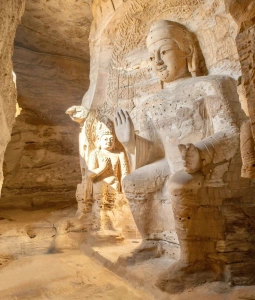
Yungang Grottoes Map
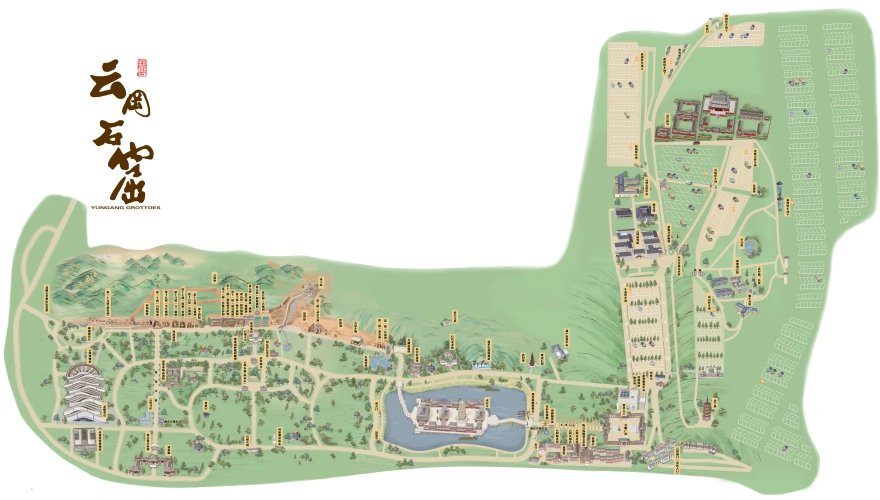
Why You Should Visit Yungang Grottoes
Historical Significance and Cultural Value
Construction of the Yungang Grottoes began during the reign of Emperor Wencheng of the Northern Wei Dynasty, around 460 CE. It was the first royal Buddhist cave temple complex in China following the eastward transmission of Buddhism, blending Central Asian artistic influences with traditional Chinese style. The site reflects the powerful alliance between the Northern Wei regime and Buddhism. Marking the beginning of the Sinicization of Buddhist cave art, the Yungang Grottoes carry immense historical significance. In 2001, the site was added to the UNESCO World Heritage list, preserving a vivid cultural record of multi-civilizational exchange and mutual influence.
Artistic Value
The sculpture art of Yungang represents the pinnacle of Chinese stone carving in the 5th century. The carvings are grand in scale and rich in detail. The site includes 45 main caves, 209 subsidiary caves, and over 18,000 square meters of carved surface area. Statues range in size from 17 meters to just 2 centimeters, and there are more than 1,100 niches and approximately 59,000 individual figures. These masterpieces reveal the artistic style and craftsmanship of the Northern Wei period, making Yungang an invaluable repository of ancient Chinese sculpture.
Top Things to Do in Yungang Grottoes
Main Attractions
Lingyan Temple
Lingyan Temple marks the historical origin of the Yungang Grottoes. Its name originally referred to the entire cave complex, and during the Northern Wei Dynasty, it served as an official place of royal Buddhist worship. What visitors see today is a reconstruction from the Ming and Qing Dynasties, presenting a harmonious fusion of Buddhist ritual architecture and traditional Chinese temple design.
This is not only a place of pilgrimage but also the first stop for those seeking to understand the cultural background of the grottoes. Built against the hillside, the temple’s main hall stands grand and imposing, often shrouded in incense smoke, blending perfectly with the solemn stone caves in the rear. From the steps in front of the temple, one can see the towering cliff carved with ancient Buddhist figures, standing as eternal guardians over this sacred land in western Datong.
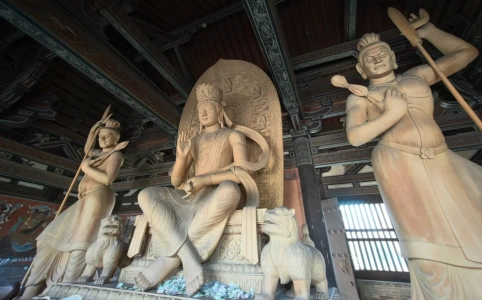
Cave Area
The main body of the Yungang Grottoes is the cave area, with 45 major caves still preserved. Among them, Cave 3 and Cave 5 are the most iconic and artistically valuable, making them must-sees.
Cave 3 | A Royal Symbol of Dignity: Cave 3 is the largest and most elaborately decorated cave in the complex, commonly referred to as the “Great Statue Cave.” It was likely excavated during the reign of Emperor Wencheng of the Northern Wei. In the center of the cave stands a 17-meter-high seated Buddha, with a dignified expression and majestic presence, believed to symbolize royal authority. The inner walls are filled with miniature Buddha niches and bas-reliefs. The precise designs and fluid lines reflect exquisite craftsmanship and profound Buddhist artistic mastery.
Cave 5 | A Harmonious Blend of Buddhism and Architecture: Cave 5 is a representative of the early Yungang style and a prime example of how foreign art was localized. At its center stands a 13.7-meter-tall Buddha statue, flanked by lifelike, proportionally balanced attendants that show strong realism. The cave’s standout features include intricate ceiling carvings and wall reliefs, whose complexity and aesthetics rival those of ancient Greek temples.
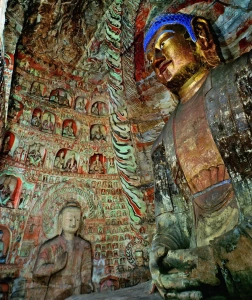
Yungang Grottoes Ticket Guide
Yungang Grottoes Ticket Prices
- Adults:
- Peak Season (April to October): 120 CNY
- Off Season (November to March): 100 CNY
- Children/Students:
- 60 CNY in peak season, 50 CNY in off season.
- Applies to children from 6 (exclusive) to 18 years old (inclusive) and full-time students at the undergraduate level or below.
- Free Admission: Seniors aged 60 and above; children under 6 years old or under 1.2 meters in height.
Where to Buy Tickets
- Online: Through third-party travel booking platforms.
- Ticket Purchase: Trip.com Discounts
- Offline: Visitor Service Center. During the peak season, it is highly recommended to buy tickets online to avoid sold-out situations.
Yungang Grottoes Tour Guide Services
Yungang Grottoes provides official tour guide services. Once you enter the site, there is an official tour counter where you can book a guide. After confirming your guide, your tour begins. It’s definitely recommended to book one if available.
- Duration: 1.5 hours
- Languages: Chinese, English
- Fees: Chinese-speaking guides range from 180 to 380 CNY depending on the guide’s level (the top-level “Gold Guide” is rarely available). English-speaking guide service costs 380 CNY. For groups under five, you must also rent headsets at 10 CNY.
Recommended Yungang Grottoes Route
Route: Enter the scenic area → walk along Tanyao Square → proceed through the Pilgrimage Avenue → visit Lingyan Temple (Qianfo Hall and Mahavira Hall) → after passing through the “Entering the Realm of the Buddha” gate, you reach the cave area (a side valley above the right holds the Dragon King Temple) → the cave area (45 preserved caves in total, from Cave 1 to the Northern Wei-era anonymous monk’s stupa at the far west) → exit through the western side of Tanyao Square into the local food street.
Note: There’s no need to buy the shuttle bus ticket; the walking distance is very manageable.
If you’re short on time, focus on these highlighted caves:
- Cave 3: The largest cave in Yungang
- Cave 5: The Great Buddha Cave with the tallest Buddha figure (17m); Cave 5 and Cave 6 form a twin cave complex featuring triad Buddhas, with wooden pavilions from the Qing Dynasty in front of each
- Cave 12: Known as the “Music Cave,” featuring a wide range of musical figure sculptures in the front chamber
- Cave 13: Home to a 13-meter-tall cross-legged bodhisattva with a pearl in its mouth
- Cave 15: “Thousand Buddha Cave,” filled with countless miniature niches
- Caves 16–20: The Tanyao Five Caves
- Cave 16: Features a 13-meter-tall standing Buddha
- Cave 17: The only early cave with a large cross-legged bodhisattva statue
- Cave 19: Houses a 16.8-meter triad Buddha, the second tallest statue in the complex; great photo spot with hands in prayer gesture
- Cave 20: The iconic outdoor Buddha of Yungang, often featured on fridge magnets and postcards
Recommended Food Near Yungang Grottoes
There are restaurants within the scenic area, but you’re better off heading to the snack street just outside the exit. Options include affordable liangfen (cold jelly noodles), sliced noodles, and even a KFC. A must-try inside the site is a drink shop called Xiaonantang · Beiwei Chashi.
Xiaonantang · Beiwei Chashi
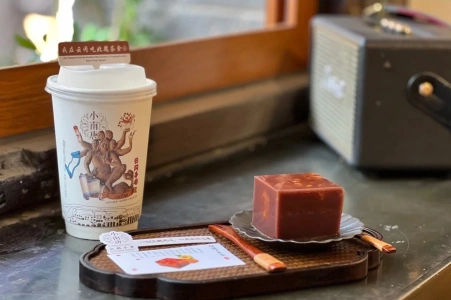
- Why it’s recommended: The must-try items are the yokan and Beiwei laojiang (fermented milk). Their matcha drinks are neither too bitter nor too sweet, with a rich aroma that makes you want to buy both types of matcha powder sold in the store.
- Address: Inside Yungang Grottoes Scenic Area, opposite Caves 7 and 8, Yungang District, Datong City (Apple Maps/Amap)
- Hours: Monday to Friday 09:00–17:00; Saturday and Sunday 08:00–18:00
- Average Price: 40 CNY per person
Recommended Hotels Near Yungang Grottoes
There are no major tourist attractions directly near the Yungang Grottoes, and since the site isn’t far from Datong’s city center, it’s much more recommended to stay inside the Datong Ancient City. The area near the Drum Tower is ideal, offering easy access to all major sites and plenty of local dining options.
Renyi Inn
.webp)
- Location: 5-minute walk from Huayan Temple
- Price per night: 288 CNY
- Check Rates: Trip.com Specials
- Rating: Trip 9.8
- Special Amenities: Family rooms
The hotel is well located. On the right, the entrance to the western city wall is very close and offers bike rentals. To the left, it’s only a short walk and turn to Huayan Temple, and right across from the temple’s exit is the Fenglin Pavilion.
All rooms follow a loft apartment design, with a remote-controlled skylight and a small balcony facing Huayan Temple—perfect for enjoying tea and the view. Even though the inn is by the roadside, once the doors are closed, it’s completely quiet. The rooms are also well maintained and clean.
Pipa Old Inn
.webp)
- Location: 5-minute walk from Drum Tower
- Price per night: 448 CNY
- Check Rates: Trip.com Specials
- Rating: Trip 9.6
- Special Amenities: Laundry room, family rooms, rooms for up to 8 guests
The location is excellent, just near the Drum Tower. There’s a nearby bus stop with access to Routes 38 and 61. Dining options around the hotel are abundant.
The rooms are clean, comfortable, and well-equipped, including smart toilets. Facilities are in great condition. Breakfast is relatively rich, and many international guests choose to stay here.
How to Get from Datong City Center to Yungang Grottoes
Datong does not have a subway system. Therefore, the best way to get to Yungang Grottoes from the city center is by bus. If you’re staying in Datong Ancient City, a simple transfer is usually enough. For groups, taking a taxi is also easy and affordable.
Bus
Go to the “Bus Company No. 4” terminal and take Bus Line 3 directly to Yungang Grottoes. The fare is only 2 CNY and the ride takes about 30 minutes. Since buses can use designated lanes, you’ll avoid traffic congestion.
Taxi/Ride-hailing
If you’re taking a taxi directly from Datong Ancient City, the fare is around 20 CNY and takes about 30 minutes.
How to Get from Datong Yungang International Airport to Yungang Grottoes
There is no direct shuttle bus from Datong Yungang International Airport to the Yungang Grottoes. If you want the cheapest option, take a bus from the airport to Datong Ancient City and transfer from there to the grottoes.
Bus
Take Bus Route 605 directly from the airport to “Caofulou Community East” stop. Then transfer to Bus Route 38 and get off at “Tongquan Road & West Ring Road” intersection. From there, take another transfer to reach the Yungang Grottoes. The total fare is around 5 CNY, and the journey takes approximately 2 hours.
Taxi/Ride-hailing
A direct taxi ride from the airport to Yungang Grottoes costs about 90 CNY and takes around 50 minutes.
FAQ
Strollers are manageable, but wheelchairs are not very convenient. Although most of the paths inside Yungang Grottoes are flat, many caves require walking up stairs. If someone cannot walk at all, they won’t be able to access the main parts. However, for those who can walk short distances, the grottoes have decent accessibility. The visitor center also offers wheelchair rentals at 20 CNY per hour with a 600 CNY deposit.
Yungang Grottoes offers free lockers for luggage storage, available from 9:00 AM to 4:30 PM. Large suitcases can also be stored. If lockers are full, you can ask vendors in the scenic area, who usually charge around 5 CNY per item.

 English (US)
English (US)  English (Hong Kong)
English (Hong Kong)  English (Malaysia)
English (Malaysia)  English (Singapore)
English (Singapore)  繁體中文
繁體中文 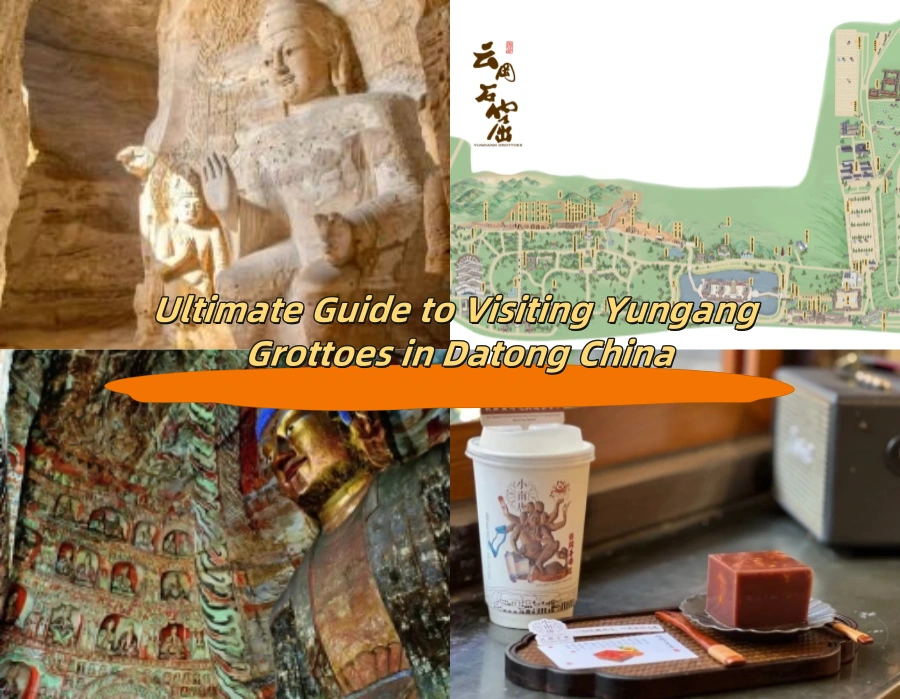
Comment (0)